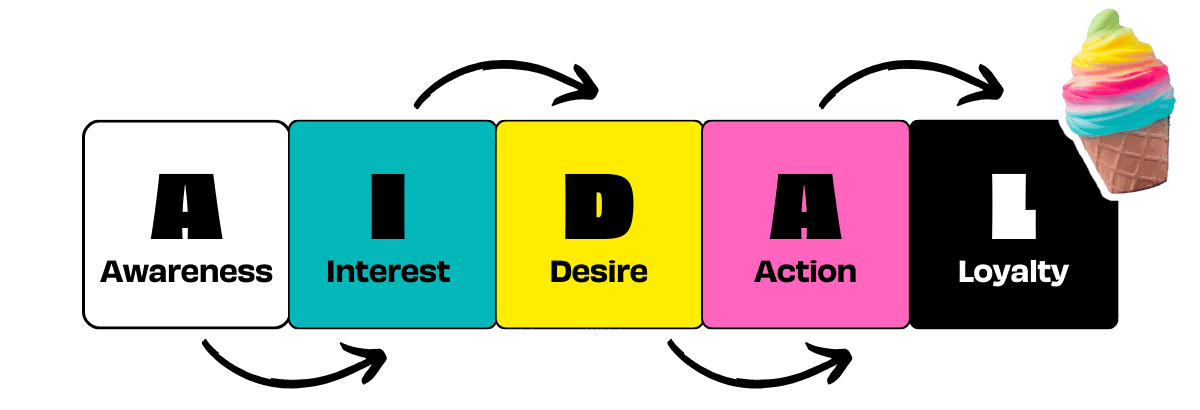want some cookies?
We use cookies to make your browsing experience amazing.

It’s easy to assume in L&D that our audience does not have a choice when it comes to learning – they have to get involved, right?! Wrong. Our audience does have a choice, they have a choice about whether they want to engage or not, and if they do engage – they have a choice about how much they partake in. And it’s our job as L&D pros to influence that decision. Enter: The decision-making journey framework.
Here at MAAS we use a handy little model called the AIDAL model, to depict audience journeys with learning. Right from the start when they’re unaware of the offering, through to becoming loyal advocates of our offering.
MEET THE AIDAL FUNNEL
AIDAL stands for Awareness, Interest, Desire, Action, and Loyalty. These stages represent the steps that learners go through when engaging with your learning offering.

Let’s dig into the stages a bit more…
AWARENESS
At this point, your audience becomes aware of your learning offering. But, their attention is split. They’re probably thinking about their day job, their family, social activities, dealing with difficult colleagues and much more. But you might realise I didn’t mention learning here… because the truth is, no matter how much we’re thinking about our learning, our audience probably (definitely) isn’t thinking about it at the awareness stage. #SozNotSoz
INTEREST
Moving down the funnel, we arrive at the Interest stage. Your audience has now shown some interest in your learning offering, but it’s still not their primary interest, focus or goal right now. At this stage they’re likely to be more focused on the end-goal of what would happen after getting involved with your learning offering, for example getting a promotion, a pay rise or acquiring a new skill.
DESIRE
Alright, now they want your offering. They’re researching what’s on offer, and what it involves. They're thinking about logistics. They’re considering alternatives. They want the end outcome… and they’re trying to decide whether your offering is right for them.
And the harsh truth is, their answer might be “no”. They might drop out of your funnel at this stage and go to an alternative learning provider, or to YouTube or Google, or maybe they’d just ask a colleague.
But let’s assume the answer is “Hell yeah!” and they carry on through the funnel…
ACTION
They’ve taken the leap and they’re actively moving through your learning journey. Marketing is still critically important at this stage as we want to maintain engagement throughout the learning process. We don’t want people to sign up and not finish learning, do we?!
LOYALTY
You might think your job is done once an individual has finished taking part in your learning intervention – but it’s not. If you want to get the most out of your marketing initiatives, you must continue effective communications after your learning is finished, to turn alumni into advocates of your learning brand. Once you’ve achieved this level of engagement with your audience, your people will start marketing your content for you, and isn’t that what we all want?!
BUILDING THE LEARNER DECISION-MAKING FRAMEWORK
Now we know what the AIDAL model is, and what it stands for, how do we convert this into a decision making framework? Using the AIDAL model, we will now step into our audiences shoes, and think about their activities, goals, thoughts and emotions at each stage. It’s a task of empathy, and I’ll admit, it’s not always easy. But in doing so, we form a deeper understanding of our audience, and can more effectively influence their behaviour – nudging them down the funnel all the way to loyalty.
Let’s look at each step in more detail…
ACTIVITIES
Consider what your learners are doing at each stage of the funnel. What tasks are they completing? How are they spending their time? Remember that not all activities will be learning-related. In fact, earlier in the AIDAL, I highly doubt anything they’re doing has anything to do with learning! Learner’s have busy lives filled with work, family, and social commitments. Acknowledge their priorities and bake them into your framework.
GOALS
As an L&D professional, it's easy to assume that your audience's goals are primarily related to learning. But again, this isn’t the case. While some learners may indeed have learning-related goals, many will have broader aspirations. Goals like career advancement, work-life balance, or personal growth may be very important to them. Your learning offering should be designed to support these diverse objectives, and when building your framework, you should be hyper-aware of these bigger goals.
THOUGHTS & FEELINGS
This is where empathy really comes in. When filling out the thoughts and feelings sections of your framework, you must truly put yourself in your learners shoes. Avoid superficial emotions like 'happy' or ‘sad’, and delve into the full wheel of emotions. Perhaps your audience is feeling inspired, overwhelmed, or inadequate. Whatever they’re feeling, make sure you capture these emotions as authentically as possible.
BEING REALISTIC WITH YOUR FRAMEWORK
While optimism is essential, we’ve got to be realistic throughout our decision making framework. Do not fall into the assumption of positive intent. Not all of your audience will have the best experience. What happens if someone has a negative encounter with your learning offering? How might that affect their journey through the AIDAL funnel? This kind of realism will help you to develop more effective, sophisticated marketing strategies. #YoureWelcome
BUT SURELY EACH MEMBER OF MY AUDIENCE WILL GO THROUGH A DIFFERENT JOURNEY?
Absolutely! Of course, each of your people will go through their own unique journey. And the framework makes some broad assumptions. But the best way to get the most impact out of your decision making framework is to grab your learner personas, and create a journey for each of them. This way you have a holistic view of what each of your personas are encountering as they go through your learning journey.
TRANSFORM YOUR MARKETING WITH LEARNER DECISION MAKING JOURNEYS
I truly believe that understanding the learner decision-making process is the key to engaging your audience effectively. The AIDAL model gives you a roadmap to guide your learners from awareness to loyalty. Building a learner decision-making framework grounded in empathy allows you to view the learning journey from your audience's perspective. Making it entirely unique to your organisation, audience and learning offering.









